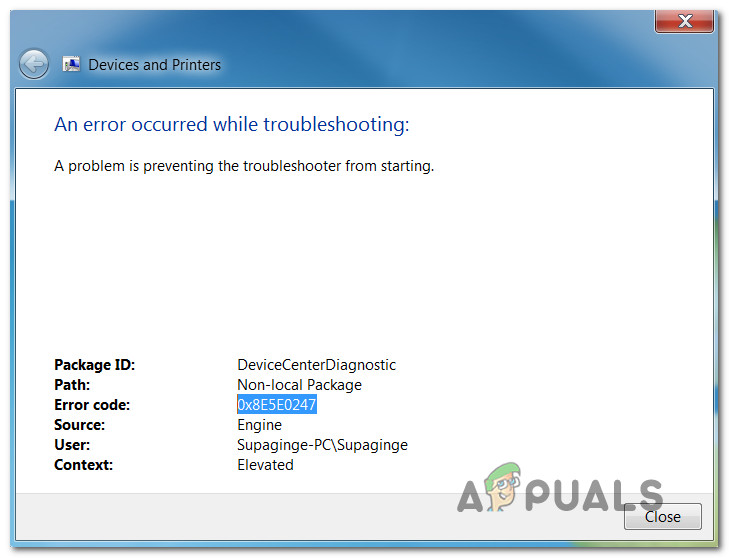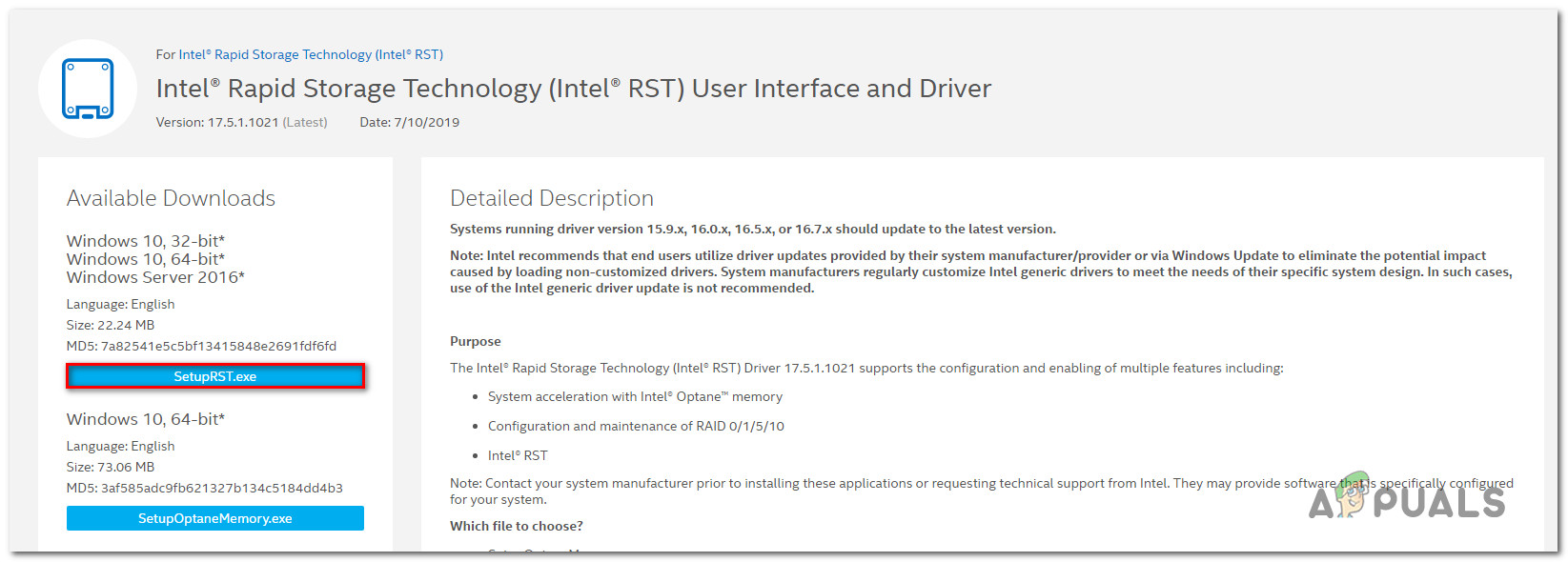How to Fix 0x8e5e0247 Error on Windows
Several Windows users have been reaching with questions after seeing the 0x8e5e0247 error code when performing various actions. In most cases that we’re brought to our attention, the error code occurs when users try to use the Windows Update function or when they try to use one of the built-in troubleshooting utilities. Although the issue is not exclusive to a certain Windows version, it’s most commonly reported to occur on Windows 7.

What is causing the 0x8e5e0247 error?
We investigated this particular issue by looking at various user reports and the repair strategies that are most commonly being used to fix this particular error code. As it turns out, there are multiple culprits that have the potential of causing this error message:
- Intel RST driver is outdated – The most common cause for this issue is an outdated Rapid Storage Driver that is not capable of handling the storage size present on the system configuration. This typically happens right after the user upgrades to a new storage disk. In this case, you should be able to resolve the issue by updating the Intel Rapid Storage Technology Driver to the latest.
- Intel Matrix Storage is conflicting with a similar driver – This utility is known to trigger this particular error in instances where the user has also installed a dedicated or Generic driver that brings the same functionality. If this scenario is applicable to your situation, you should be able to resolve the issue by uninstalling the Intel Matrix Storage utility.
- System file corruption – Another possible culprit that will trigger the 0x8e5e0247 error is system file corruption. There are confirmed instances where this particular error code was resolved after affected users identified & repaired corrupted items with utilities like SFC or DISM. If corruption is more severe, a repair install should be the preferred method.
If one of the scenarios above is applicable to your type of problem, this article will provide you with several different troubleshooting strategies. Down below, you’ll find several methods that other users in a similar situation have successfully used to resolve the 0x8e5e0247 error code.
If you want to remain as efficient as possible, we advise you to follow the potential fixes below in order since we ordered them by efficiency and severity. You should eventually stumble upon a method that will allow you to fix the problem regardless of the culprit that’s causing it.
Let’s begin!
Method 1: Updating the Intel Rapid Storage Technology
If you started getting this error message after upgrading your PC configuration with a new HDD or SDD, chances are the issue is occurring due to an old Intel Rapid Storage Technology driver that doesn’t know how to work with your current drive size.
If this scenario is applicable, you should be able to resolve the issue by updating your Intel Rapid Storage Technology driver version to the latest using the official channels. Similar users struggling to resolve the same error message have reported that they managed to fix the issue indefinitely after following the instructions below.
Here’s what you need to do in order to update the Intel Rapid Storage Technology driver:
- Visit this link (here) and click on the latest version of the Intel Rapid Storage Technology (Intel RST) driver.
- Once you arrive at the next screen, look in the left-hand section of the screen and download the SetupRST executable.

Downloading the installation executable of the Intel RST driver - Next, agree with the ToS and wait until the download is complete.
- Once the installation executable is downloaded, double-click on it and follow the on-screen prompts to complete the installation of the latest version of the Intel RST driver.
- When the installation is complete, restart your computer manually if you’re not prompted to do so.
- Once the next startup sequence is complete, repeat the action that was previously triggering the 0x8e5e0247 error code and see if the issue has been resolved.
If you see the same problem still occurring, move down to the next method below.
Method 2: Uninstalling Intel Matrix Storage
As it turns out if you’re using Intel Matrix Storage but you’ve also installed the Intel Rapid Storage driver (or the AMD equivalent) chances are you’re seeing the 0x8e5e0247 error code due to a conflict between the two drivers that are basically doing the same thing.
In this case, you should be able to resolve the issue by using the Programs and Features utility to uninstall the Intel Matrix Storage utility. Several users encountering the same issue have reported that the error code was no longer occurring after following the instructions below and restarting their computer.
Here’s what you need to do:
- Press Windows key + R to open up a Run dialog box. Then, type “appwiz.cpl” and press Enter to open up the Programs and Features utility.

Type appwiz.cpl and Press Enter to Open Installed Programs List - Once you’re inside the Programs and Features screen, scroll down through the list of installed applications and locate Intel Matrix Storage. When you see it, right-click on it and choose Uninstall from the context menu.

Uninstalling the Intel Matrix Storage application - Follow the on-screen prompts to complete the uninstallation, then restart your computer.
- At the next startup sequence, see if the problem has been resolved by repeating the action that was previously triggering the error.
If you’re still seeing the 0x8e5e0247 error code, move down to the next method below.
Method 3: Performing SFC and DISM scans
Another potential scenario with the potential to produce the 0x8e5e0247 error code is some kind of system file corruption that is inhibiting the functionality of Windows Update or Windows Troubleshooter. If this case is applicable, you should be able to resolve the issue by fixing the corruption with utilities like DISM (Deployment Image Servicing and Management) or SFC (System File Checker).
Both of these utilities will ultimately fix corrupted system files, but they do it in different ways. SFC uses a local cache to replace corrupted files with healthy options while DISM uses Windows Update to download fresh copies.
If you suspect that system file corruption might be causing the issue, we recommend running both of these utilities in the order below. Here’s what you need to do to perform SFC and DISM scans:
- Press Windows key + R to open up a Run window. Then, type ‘cmd’ and press Ctrl + Shift + Enter to open up an elevated Command Prompt. When you see the UAC (User Account Control), click Yes to grant admin access.

Running Command Prompt as an administrator - Once you manage to open an elevated Command Prompt, type the following command and press Enter to initiate an SFC scan:
sfc /scannow
Note: Stopping this scan in the middle of this can bring further harm to your system files, so don’t close the CMD window or turn off your PC unexpectedly until the scan is complete. Keep in mind that depending on your PC specs and your storage space, it might take several hours.
- When the SFC scan is complete, restart your computer and see if the issue is resolved once the next startup sequence is complete.
- If you’re still encountering the 0x8e5e0247 error code, follow step 1 again to open up another elevated CMD prompt, but this time type the command below to initiate a DISM scan:
DISM /Online /Cleanup-Image /RestoreHealth
Note: Remember that DISM needs a reliable internet connection in order to download healthy copies of the files that are tainted by corruption, so make sure that you’re using a stable internet connection.
- Once the procedure is complete, restart your computer again and see if the issue is resolved at the next system startup.
If you’re still encountering the 0x8e5e0247 error code, move down to the final method below.
Method 4: Performing a repair install
If the two built-in utilities presented above didn’t allow you to resolve the 0x8e5e0247 error code, it’s likely that you’re system is struggling with some severe corruption (possibly affecting some essential OS files).
If this scenario is applicable, you should be able to fix the issue and avoid a clean install by performing a repair install instead. This procedure will reset all Windows components including booting data. But the good thing about this method is that it will leave all your personal files intact – This means that your applications, user preferences and media (images, videos, documents) will not be deleted.
In case you decide to go for a repair install, you can follow the instructions inside this article (here).




